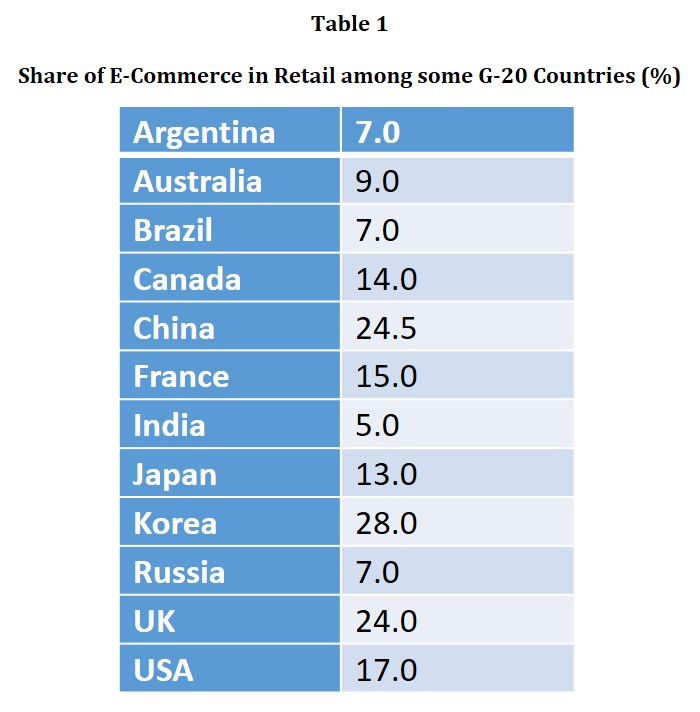E-Commerce globally is on the rise. Relentless innovation in technology, endless consumer’s demand for variety of products and services, digitalization drive, advent of internet, OTT, and Covid-19 pandemic have propelled the world economy to witness an unparalleled growth in e-commerce. Over last few years, e-commerce has become an indispensable part of global retail transactions. Buying and selling of goods and cross-border transactions of services have undergone a substantial transformation allowing consumers all over the world now to benefit from the perks of online transactions.
As global internet access and penetration rapidly increase with over US$ 5.4 billion[1] internet users worldwide, the number of people making purchases online is ever-increasing. Retail e-commerce sales were estimated to have exceeded US$ 5.7 trillion in 2022[2] worldwide, and this figure is expected to reach new heights in the coming years. Among the regions globally, Asia seems to be a hotspot as it garners maximum retail revenue over last couple of years. Asia is poised to experience the highest total retail e-commerce revenue in 2023, with more than two trillion U.S. dollars. The second highest online shopping revenue would be generated in the Americas, at around US$ 1.1 trillion. African e-commerce revenue would remain the smallest worldwide, at around US$44 billion.
Current world economy continues to witness consistent rise in e-commerce though Covid-19 set the agenda aggressively. As it stands in April 2023, the number of online shoppers amounts to 2.64 billion. This is roughly about 33.4 per cent of the population worldwide signifying that one out of every three people around the world is an online shopper.[3]
Push towards e-commerce was seriously noticed around 2015. In 2015 global e-commerce valued at US$1.5 trillion.[4] By 2022 there had been more than a three-fold increase in e-commerce sales amounting US$ 4.94 trillion.[5] Over the next 3 to 4 years global e-commerce market is expected to grow exponentially almost amounting to CAGR of 20 per cent. By the end of 2021 among the G-20 countries Republic of Korea had witnessed maximum e-commerce share (28%) in retail followed by China (24.5%). India witnessed a marginal share of 5 per cent, whereas it is expected that India will witness huge jump in its CAGR by 2025. Confidence of Indian consumers towards e-commerce is growing rapidly as access to technology and internet connectivity in rural areas is fast catching up.[6] Current rate of penetration of internet is around 48.9% of India’s total population and will cover more than 70% by 2030.[7]

What could further drive growth in this sector will completely depend upon certain favourable factors such as internet connectivity, development of Information and Communication Technology (ICT), digital literacy, financial inclusion and overwhelming influence of digitalization.Indian government is fully aware of such factors and making concerted efforts at local, industry, state and central level to give a real boost to the sector by promoting digital literacy, developing skills, making investment and creating technological innovation and infrastructure. E-commerce is a direct result of ICT and thus its adoption and growth also necessitates urgency of ICT.[8]
Importance of e-commerce is globally well recognized. Most economies are convinced that this would soon become an important economic activity and will be a major medium of economic transaction. Its potentiality seems to be seamless. Under such growing and robust atmosphere, it is essential that a proper regulatory environment is created where economies will have free and fair transaction, and competition among e-commerce firms. This environment needs to be just, rational and non-discriminatory and cybercrime free.
E-Commerce is not an exclusive domain of any economy/government, rather intergovernmental in nature, therefore needs total cooperation and support of each other. In a world which is driven by so many economies of different size, capacity and interests, it is difficult for any institution to monitor and supervise such intricate, challenging and evolving regulatory environment, unless there is one which is trustworthy. Such trust and confidence can best remain with already existing multilateral institution such as the WTO. So the role of the WTO in this current environment towards e-commerce is paramount.
The WTO is an exclusive forum to carry out and enforce rules and regulation covering cross-border trade in goods and services. Studies have analyzed that rules based system whereby commitments already undertaken by member countries covering goods, services and IPR, can create a transparent, predictable environment for e-commerce to flourish (Wunsch-Vincent & McIntosh, 2005). Countries with such commitments towards e-commerce must take these commitments forward under current growing e-commerce activities.[9]
E-Commerce was for the first time taken up under the ambit of WTO in 1998 by creating a work programme under the General Council of the WTO. The programme was exploratory in nature and had taken into account all activities of the WTO and also looked into financial, economic and development needs of developing countries. The committee during initial period met several times to arrive at definitive and conclusive decisions. Goods, services and IPR remained the main focus. The areas in which WTO member countries couldn’t reach a consensus were classification of music and e book etc. as goods or services, and also extension of moratorium on customs duties which led to revenue losses for developing economies.
Doha Ministerial in 2001 gave a push to the agenda of e-commerce. Classification of content, development issues, fiscal implication and jurisdiction formed part of the discussion; however the work programme couldn’t proceed further. Clarity on classification of content couldn’t be established. For instance, music goods were filed as part of services by EU. So, legal validity, smooth e-transaction, taxation of e-transaction, privacy, data safety, tariffs, collection of revenue, IPR, security concerns remained the bone of contention between developed and developing countries. In subsequent multilateral fora and platforms under the stewardship of the WTO no decisive results regarding the conduct of e-commerce came about.
Such indecisiveness and slow progress of Doha Round led to the proliferation of bilateral and regional trade agreements (RTAs). The stated rationale for doing so was to improve e-commerce. Such improvement helps in scaling up appropriate regional digital ecosystem and in promoting digital societies through shared experience and cooperation. Such bilateral/regional initiative helps to foster a multilateral digital ecosystem slowly and gradually which was otherwise was not becoming feasible through initial multilateral efforts under the WTO. Proponents of such rules have indicated that having certain provisions or chapter in the agreement can harmonize e-commerce issues which will provide greater clarity and investment necessary for regions to finance digital scalability. US-Jordan FTA in 2001 is one of the first ones to focus on e-commerce activities.
These RTAs found to be more meaningful and acceptable to countries who wanted to conduct e-commerce more vociferously. Provisions of e-commerce were largely spelt out in these agreements by including market access, duty free moratorium for digital products, proving equal treatment to products emanating from developed and developing economies. Such FTAs addressed issues of authentication and certification of electronic signatures, e-certification, paperless trading, and consumeronline and data protection.
In 2017 Ministerial Conference of Buenos Aires work programme on e-commerce was reemphasized with same zeal and vigour. Electronic signature and data security remained the major hallmark of the programme with special mention of ‘not imposing custom duties in electronic transmission.’ In later years India emphasized such rules and provisions and even today continues to stress upon such modalities and work programme.
India has been a staunch advocate for framing rules and regulations on e-commerce in WTO platform. It has taken active interests in suggesting that current work programme needs to be supported by majority of the WTO members, so that early implementation of rules and regulations can be carried out.
Another important aspect of e-commerce is the adoption and preparedness to face the challenges emanating out of e-commerce. Current e-commerce adoption and preparedness among major economies is not quite effective. This is visible even among important grouping like G-20. Technological adoption and preparedness among G-20 countries varies also significantly. Since G-20 is a unity of developed and developing economies, collective response towards bridging the adoption gaps in e-commerce merits immediate action. It is expected of every economy to formulate a domestic e-commerce policy that would create the basic atmosphere of e-commerce requirements and that domestic policy should be in sync with domestic e-commerce promotion and international best practices. India currently being at the helm of G-20 should push this initiative to arrive at some kind of unanimity in e-commerce rules and provision.
Data adoption for e-commerce especially for MSME sector is not available with many G-20 countries. Since MSME plays key role in economic activities, it will be of help if G-20 can devise a framework for collecting data on key indicators for e-commerce adoption through countrywide national surveys. It is important to bridge the adoption gaps for corporates, enterprise and MSMEs. Indian government has launched a new initiative called Open Network Digital Commerce (ONDC) online platform where MSME can showcase their prowess in goods and services sell. Such online platform can be designed by other economies in G-20 and their experience can be shared in the WTO relevant Working Group.
G-20 should also take interest in familiarizing developing economies with digital financial inclusion which will help emerging economies to know more about the products and services and the risks involved with it. Financial institutions in partnership with Fintech companies can create awareness about such products and services which will build up trust and confidence in e-commerce and increase financial digital inclusion.
While Covid-19 has accelerated the process and activities of e-commerce globally, yet adoption gaps persist. Lack of full proof regulatory mechanism, poor access to internet, data privacy, security concerns, lack of WTO governing rules are some of the major constraints still plaguing the system. G-20 is in a unique position to involve and influence many important actors such as the provincial governments, policymakers, local bodies, trade & industry, financial institutions, civil society, etc. to frame national domestic e-commerce policy for economies as the very first step towards e-commerce sustainability. A near perfect business climate and ecosystem for e-commerce is essential asit promises to be the lifeline of future global trade.
Endnotes :
[1]https://www.internetworldstats.com/stats.htm,accessed on April 12,2023
[2]https://www.statista.com/ accessed on April 12, 2023
[3]How Many People Shop Online in 2023? [Updated Feb 2023] (oberlo.com), accessed on April 13,2023
[4]https://www.statista.com/ accessed on April14, 2023
[5]https://www.statista.com/ accessed on April14,2023
[6]https://economictimes.indiatimes.com/tech/technology/rural-india-is-driving-internet-adoption-survey-finds/articleshow/93186625.cms accessed on April 15, 2023
[7]https://data.worldbank.org/indicator/IT.NET.USER.ZS?locations=IN accessed on April17, 2023
[8]https://www.emerald.com/insight/content/doi/10.1108/JWAM-04-2021-0030/full/pdf?title=the-effectiveness-of-workplace-coaching-a-meta-analysis-of-contemporary-psychologically-informed-coaching-approaches, accessed on April19,2023
[9]https://www.wto.org/english/tratop_e/serv_e/sym_april05_e/wunschvincent_e.pdf accessed on April 21 2023
(The paper is the author’s individual scholastic articulation. The author certifies that the article/paper is original in content, unpublished and it has not been submitted for publication/web upload elsewhere, and that the facts and figures quoted are duly referenced, as needed, and are believed to be correct). (The paper does not necessarily represent the organisational stance... More >>
Image Source: https://indiancompanies.in/wp-content/uploads/2020/09/top-e-commerce-companies-in-india-696x466.jpg










Post new comment